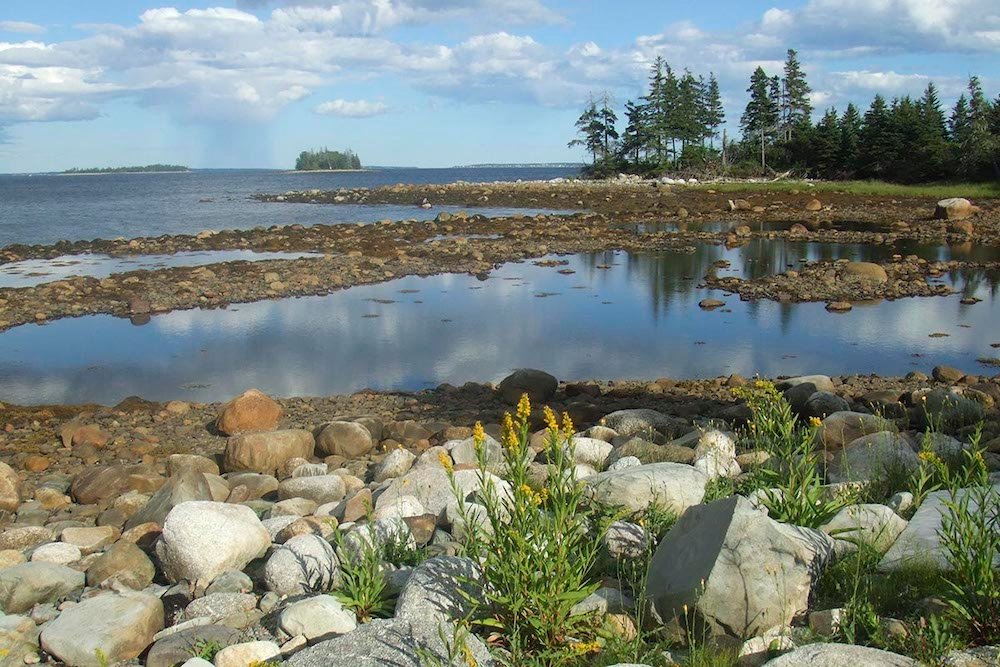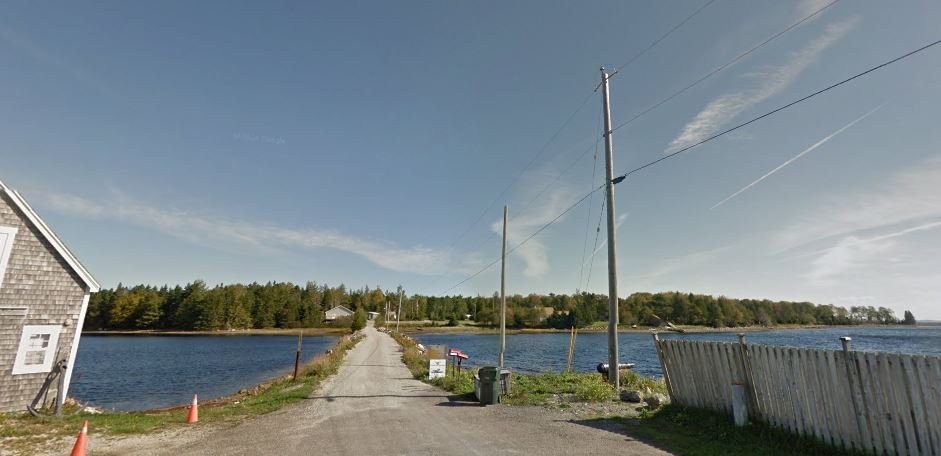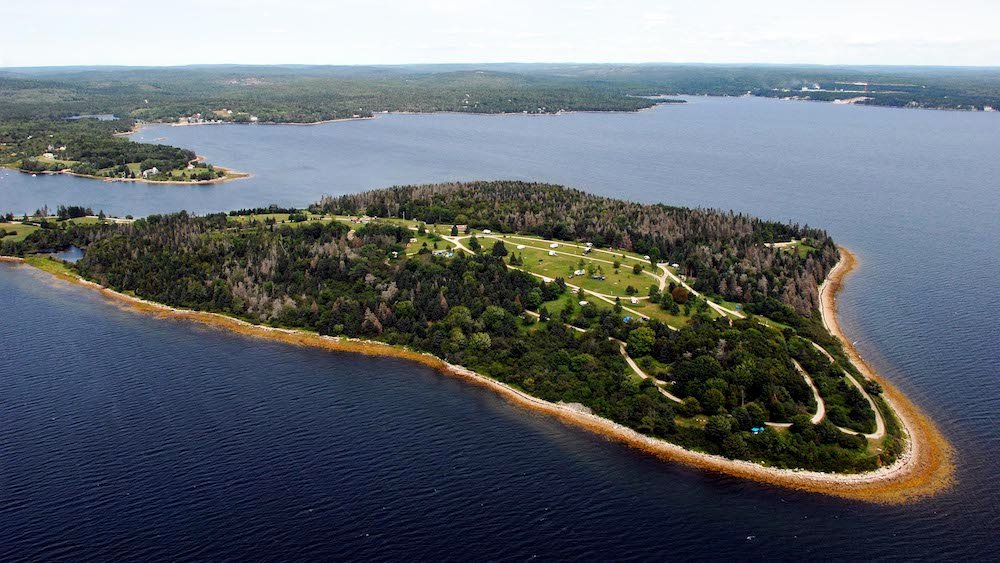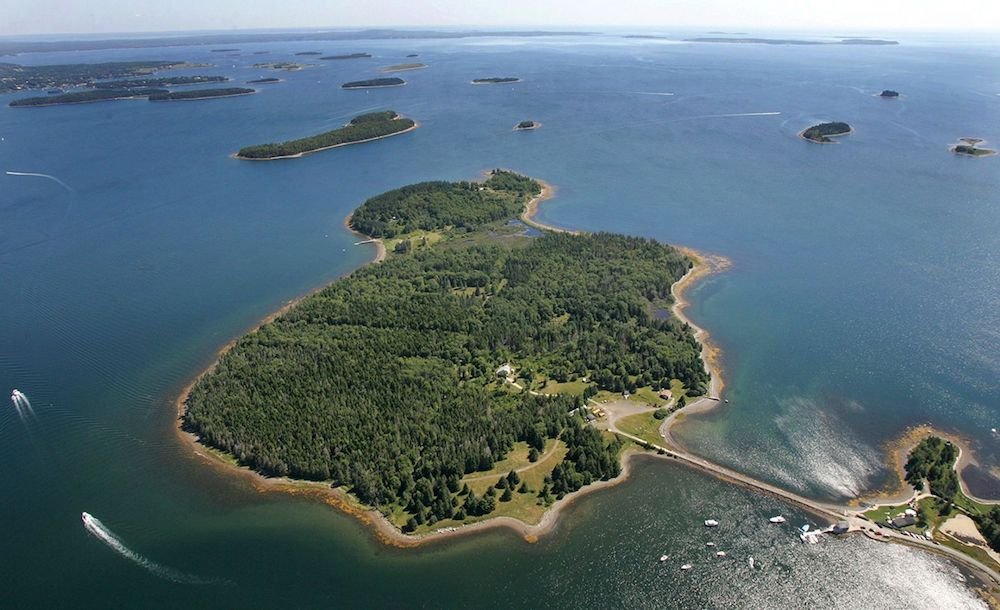
Nestled on the fog-laden shores of Nova Scotia, Canada, Oak Island is a name that has become synonymous with mystery, intrigue, and the promise of hidden treasure.
This small, forested island in Mahone Bay stands as a beacon to treasure hunters, historians, and mystery enthusiasts alike, its legend enduring through centuries.
The allure of Oak Island is not just in its supposed treasure, but also in the rich tapestry of history and the unyielding spirit of adventure that it represents.
The Geographic and Historical Significance of Oak Island
Oak Island spans approximately 140 acres, a modest size that belies its immense presence in the lore of treasure hunting.
The island’s geography, with its numerous sinkholes and underground waterways, has fueled speculation and theories about buried treasures and complex retrieval systems.
Historically, the area around Oak Island was inhabited by the Mi’kmaq people, and European settlers arrived in the 18th century.
However, it wasn’t until the discovery of a curious depression in the ground in 1795 that Oak Island’s legend as a treasure trove began to take shape.
The Legend of Oak Island’s Hidden Treasure
The legend of Oak Island’s treasure is a compelling narrative that has evolved over more than two centuries.
It began with the discovery of the “Money Pit,” a deep, man-made pit that many believe was created to hide a vast treasure.
Over the years, attempts to excavate the pit have revealed tantalizing clues, including layers of logs, coconut fiber, and even a mysterious inscribed stone, suggesting that something of great value was intentionally buried deep within the island.
The mystery of Oak Island has captivated the imaginations of people around the world, leading to numerous expeditions, theories, and even tragedies.
From tales of pirate booty hidden away by the likes of Captain Kidd, to speculation about the lost treasure of the Knights Templar, the possible origins of Oak Island’s treasure are as varied as they are fascinating.
This enduring mystery has not only made Oak Island a focal point of treasure hunting lore but has also cemented its place in popular culture as a symbol of the eternal human quest for discovery and the unknown.
The Legend of the Oak Island Treasure

The legend of the Oak Island treasure is a saga that has intrigued and baffled treasure hunters, historians, and enthusiasts for over two centuries.
Its origins trace back to the late 18th century, when a young man named Daniel McGinnis discovered an intriguing circular depression on the island’s surface.
This discovery, along with stories of lights seen on the island and the lore of pirates in the region, sparked the beginning of the Oak Island treasure hunt—a quest that continues to this day.
Origin of the Treasure Legend
The story begins in 1795 when McGinnis, exploring Oak Island, found a depression in the ground beneath an old oak tree.
Further investigation revealed a block and tackle hanging from the tree, suggesting that something had been lowered into the ground.
Along with friends John Smith and Anthony Vaughan, McGinnis began to excavate the site, uncovering a layer of flagstones and a series of platforms made of oak logs at regular intervals down what would become known as the “Money Pit.”
The initial discovery and subsequent excavations, which uncovered additional mysterious features and artifacts, laid the foundation for the treasure legend that has captivated the world.
Summary of Various Theories About the Treasure’s Origins
Over the years, a multitude of theories have emerged regarding the origins of the Oak Island treasure.
These theories range from plausible historical conjectures to the more speculative and fantastical.
- Pirates’ Treasure: One of the most enduring theories suggests that the infamous pirate Captain Kidd buried his treasure on Oak Island. The region’s history of piracy lends credence to this idea, and many early treasure hunters were motivated by the prospect of uncovering a pirate hoard.
- Knights Templar Connection: Another popular theory posits that the Knights Templar, a medieval Christian military order, buried sacred religious artifacts, such as the Holy Grail or the Ark of the Covenant, on the island. Supporters of this theory cite connections between the Templars and the early Scottish settlers of Nova Scotia.
- Marie Antoinette’s Jewels: A more recent theory suggests that the treasure could include jewels belonging to Marie Antoinette. According to this theory, the jewels were smuggled out of France during the revolution and hidden on Oak Island by the French naval officer, the Duke de la Rochefoucauld, with the help of the French Masonic lodge, to which many of the early searchers belonged.
- Naval Treasures: Some theories propose that the British military or the Spanish Navy buried spoils of war or looted treasures on the island for safekeeping during the numerous conflicts of the 17th and 18th centuries.
Each of these theories, while varying in details and plausibility, reflects the wide-ranging speculation that the mystery of Oak Island has inspired.
The treasure’s true nature and origins remain as elusive as ever, fueling continued interest and exploration.
The legend of the Oak Island treasure, with its rich tapestry of historical intrigue, daring exploration, and the unquenchable human thirst for adventure, remains one of the most captivating mysteries of our time.
As treasure hunters past and present have discovered, Oak Island keeps its secrets well, offering only tantalizing clues that lead ever deeper into the mystery.
Historical Excavations and Discoveries

The quest for the Oak Island treasure has seen numerous expeditions, each adding a layer to the island’s mystery.
From the initial dig by Daniel McGinnis and his friends in 1795 to modern-day excavations equipped with the latest technology, the island has been a site of relentless pursuit, intriguing finds, and daunting challenges.
Timeline of Significant Excavation Attempts
- 1795: The discovery of the Money Pit by Daniel McGinnis and his team marks the beginning of the Oak Island treasure hunt.
- 1800s: Various companies, including the Onslow Company and the Truro Company, undertake extensive excavations, uncovering the “90-foot stone” and encountering the first flood tunnels.
- 1897: The Oak Island Association discovers what is believed to be a part of a gold chain and further evidence of flood tunnels.
- 1931: William Chappell and Frederick Blair uncover numerous artifacts, including an anchor fluke and evidence of previous search tunnels.
- 1965: Robert Restall attempts to solve the mystery but tragically dies along with his son and two workers in an accident on the island.
- 1970s: Triton Alliance Ltd. conducts significant excavations, using heavy machinery to drill into the Money Pit area, discovering various items but no conclusive treasure.
- 2000s-Present: Armed with advanced technology, teams continue to search, most notably the Lagina brothers, who star in the television series “The Curse of Oak Island,” uncovering intriguing artifacts and further evidence of complex underground structures.
Key Discoveries
- The Money Pit: Originally discovered in 1795, this deep, man-made pit has been the focus of treasure hunters for over two centuries. Its elaborate construction, with layers of logs, charcoal, and coconut fiber, suggests a significant effort to hide something of value.
- The “90-Foot Stone”: Found by the Truro Company in 1804, this stone reportedly bore an inscribed code, which some believe indicates the treasure’s nature or location. Its authenticity and whereabouts have been subjects of speculation.
- Booby Traps and Flood Tunnels: Excavators encountered seawater-flooded tunnels, ingeniously designed to protect the Money Pit from being accessed. These flood tunnels have thwarted many efforts to reach the bottom of the pit.
- Smith’s Cove: Discoveries here include a U-shaped structure and coconut fiber, suggesting engineering efforts to either protect a buried treasure or to facilitate its retrieval.
Challenges Faced by Treasure Hunters
The search for the Oak Island treasure has been fraught with numerous challenges:
- Financial Constraints: The cost of excavations, often involving sophisticated machinery and large teams, can be prohibitive, leading many expeditions to end prematurely.
- Technological Limitations: While technology has advanced significantly, the complex nature of the island’s underground structures and booby traps has made treasure retrieval exceedingly difficult.
- Natural Obstacles: The island’s geography, with its waterlogged soil and the presence of flood tunnels, has made digging hazardous. Tragic accidents, like the one that claimed the lives of Robert Restall and his team, underscore the dangers involved.
- Legal and Environmental Regulations: Modern treasure hunters must navigate a maze of regulatory requirements, balancing the pursuit of the treasure with the need to protect the island’s natural environment and historical sites.
Despite these obstacles, the allure of Oak Island’s treasure continues to draw explorers, each hopeful to uncover the mystery that has eluded so many before them.
The history of excavations on Oak Island is not just a chronicle of the search for treasure, but a testament to human curiosity, determination, and the enduring appeal of the unknown.
Theories and Speculations About the Treasure

The mystery of Oak Island’s treasure has given rise to a myriad of theories concerning its origins, the identities of those who buried it, and their reasons for doing so.
These theories span the realms of historical fact, speculation, and outright legend, each supported by various pieces of evidence, however circumstantial or interpretive.
Popular Theories Regarding the Treasure’s Origins
Pirates’ Treasure
The theory that pirates buried their loot on Oak Island is among the most enduring.
Supporters of this idea often cite the island’s proximity to the routes used by pirate ships in the 17th and 18th centuries.
The infamous pirate Captain Kidd is frequently mentioned, with some believing he used the island as a cache for his plundered riches.
While this theory romanticizes the pirate era, direct evidence linking specific pirates to the island remains elusive.
Knights Templar Treasure
Another compelling theory suggests that the treasure belongs to the Knights Templar, the medieval Christian military order.
Proponents argue that after the persecution of the Templars in the early 14th century, the surviving members could have transported their treasure, including possibly the Holy Grail or the Ark of the Covenant, to Nova Scotia for safekeeping.
This theory is bolstered by the discovery of medieval artifacts and structures on the island that some interpret as Templar symbols.
Marie Antoinette’s Jewels
A more recent theory posits that the treasure could comprise jewels and valuables belonging to Marie Antoinette.
The theory suggests that during the French Revolution, these items were smuggled to Nova Scotia by the French navy, with Oak Island chosen as the hiding place.
Though romantic and intriguing, concrete evidence for this theory is scant, relying largely on anecdotal connections between historical figures and the island.
Naval Stores or Payroll
Some speculate that the British military or the Spanish navy may have buried stores of value or payroll on the island to protect them from enemy forces or pirates.
This theory is supported by Oak Island’s strategic location and historical accounts of military activities in the area.
However, like many theories about Oak Island, definitive proof remains just out of reach.
Evidence Supporting Various Theories
- Historical Documents: Various historical documents and maps have been interpreted to suggest activity on Oak Island by pirates, the French navy, or other historical figures. Some documents allegedly point to specific locations on the island where treasure could be buried, though their authenticity and interpretations are debated.
- Artifacts: The discovery of artifacts ranging from 16th-century coins to pieces of ancient jewelry and tools has provided tantalizing hints at the island’s past visitors. Proponents of different theories use these findings to support their speculations, though the artifacts often raise more questions than they answer.
- Geological Studies: Geological examinations of Oak Island have revealed anomalies and structures that suggest human activity. For example, the presence of non-native coconut fiber suggests extensive efforts to construct flood defenses, potentially to protect a valuable treasure. However, the geological evidence can be interpreted in various ways, often depending on the preexisting beliefs of the interpreters.
The theories and speculations about Oak Island’s treasure are as varied and complex as the history of the island itself.
While evidence can be found to support many of these theories, none has yet provided a definitive answer to the mystery.
The true story of Oak Island, if it is ever fully uncovered, may well encompass elements of several theories or reveal a truth entirely unexpected.
Modern Exploration Efforts

The quest for the Oak Island treasure has entered a new era, characterized by advanced technology, high-profile explorations, and significant media attention.
In recent years, modern treasure hunters have brought new life to the centuries-old mystery, equipped with resources and technology unimaginable to their predecessors.
Recent Expeditions and Key Players
One of the most significant modern efforts to unravel the mystery of Oak Island has been led by Rick and Marty Lagina.
The Lagina brothers, originally from Michigan, USA, were captivated by the Oak Island mystery from a young age.
Since acquiring a major interest in the island in 2006, they have spearheaded a comprehensive exploration effort, documented in the popular History Channel series “The Curse of Oak Island.”
Their team combines historical research, scientific method, and a range of technical expertise in its quest to solve the mystery.
The Laginas are supported by a diverse team, including Dan Blankenship, a treasure hunter who devoted much of his life to exploring Oak Island before his passing in 2019, and a host of experts in fields such as geology, archaeology, and metal detection.
Together, they represent the latest in a long line of treasure hunters driven to uncover the island’s secrets.
The Role of Modern Technology
Modern technology has transformed the search on Oak Island, allowing for deeper, more precise exploration than ever before.
Ground-penetrating radar, 3D seismic imaging, and drone photography are among the tools now used to peer beneath the island’s surface, identifying potential sites of interest without the need for invasive digging.
Advanced metal detection equipment and underwater ROVs (Remote Operated Vehicles) are employed to explore the waters around and beneath the island, revealing artifacts and features obscured by centuries of sediment and water.
These technologies have not only allowed for a more targeted search but have also reduced the risk of activating the island’s notorious flood traps, which have thwarted many previous efforts to reach the speculated treasure chambers.
Significant Findings and Impact on Current Understanding
Recent exploration efforts on Oak Island have yielded a number of significant findings.
Artifacts dating back several centuries, including old coins, brooches, and pieces of military uniforms, have been uncovered, offering tantalizing hints at the island’s history of human activity.
Perhaps more significantly, the team has discovered evidence of pre-colonial presence on the island, including structures and tools that predate the earliest known European settlers in the area.
The discoveries made by the Lagina brothers and their team have not only added to the collection of intriguing artifacts but have also helped to refine the understanding of Oak Island’s complex history.
While the ultimate treasure remains elusive, each finding contributes to a greater understanding of the island’s past occupants and their activities, providing new clues to the mystery that has captivated imaginations for over two centuries.
The modern exploration of Oak Island represents the culmination of human curiosity, perseverance, and technological innovation.
As the search continues, each effort builds upon the last, drawing us ever closer to unraveling the enduring mystery of Oak Island’s hidden treasure.
The Cultural Impact of Oak Island’s Mystery

The mystery of Oak Island has transcended its origins as a local legend, embedding itself into the fabric of popular culture and captivating audiences worldwide.
Its blend of historical intrigue, treasure hunting, and the allure of the unknown has proven irresistible, inspiring a wide range of creative and scholarly pursuits.
Influence on Popular Culture
The saga of Oak Island has been the subject of numerous books, television shows, and documentaries, each contributing to the legend’s mystique.
Perhaps the most notable example is the hit television series “The Curse of Oak Island,” which follows the modern-day treasure hunt led by the Lagina brothers.
The show has not only brought the mystery to a global audience but has also revitalized interest in the island’s history and the various theories surrounding the supposed treasure.
Beyond television, Oak Island has inspired authors of fiction and non-fiction alike.
Books exploring the history of the treasure hunt, theories about the origin of the treasure, and even novels using Oak Island as a backdrop for fictional tales have found eager audiences.
Documentary films and specials have also delved into the island’s mysteries, often with a focus on specific aspects of the legend or recent discoveries.
Attracting a Global Audience
The legend of Oak Island has drawn tourists, historians, and treasure hunters from around the world to the small Nova Scotia island.
Visitors come hoping to catch a glimpse of the famous Money Pit, walk the beaches of Smith’s Cove, or perhaps even discover a clue that has eluded searchers for centuries.
The island has become a pilgrimage site for those fascinated by its story, offering guided tours that explore its history and mysteries.
Moreover, the Oak Island mystery has fostered a vibrant community of enthusiasts who share theories, research, and speculation in online forums, social media, and at conferences dedicated to the treasure hunt.
This community spans the globe, uniting individuals of diverse backgrounds and expertise in their shared fascination with the island’s secrets.
The cultural impact of Oak Island’s mystery is a testament to the human love of storytelling and the quest for knowledge.
It showcases how a single, enigmatic story can inspire creativity, drive scientific inquiry, and bring people together in the pursuit of the unknown.
The island’s legend has become a part of our collective imagination, a symbol of the mysteries that still lie hidden in the world, waiting to be discovered.
Challenges and Controversies Surrounding the Hunt

The search for Oak Island’s legendary treasure is fraught with not just physical and logistical challenges, but also environmental, regulatory, and scholarly controversies.
These aspects add layers of complexity to an already intricate quest, impacting the methods, scope, and very continuation of the hunt.
Environmental Concerns and Regulatory Challenges
The excavation efforts on Oak Island have raised significant environmental concerns.
The island, with its unique ecosystem, has been subject to extensive digging, drilling, and other disruptive activities that risk altering its landscape and natural balance.
The potential damage to local flora and fauna, along with the alteration of the island’s water table and soil composition, has prompted calls for stricter environmental oversight.
Regulatory challenges also play a significant role in the treasure hunt.
Excavations on Oak Island are subject to a variety of local, provincial, and federal regulations designed to protect historical sites and natural resources.
These regulations can limit the scale and methods of search operations, requiring permits and oversight that some treasure hunters find restrictive.
However, these regulations are essential for ensuring that the pursuit of the treasure does not come at the expense of the island’s historical and environmental integrity.
Skepticism and Criticism from the Scientific Community
The Oak Island treasure hunt has been met with skepticism and criticism from many in the scientific and archaeological communities.
Critics argue that there is scant empirical evidence to support the existence of a significant treasure, suggesting that the legend has been embellished over time.
The lack of definitive proof, despite centuries of search efforts, has led some to question the value and motivations behind the ongoing hunt.
Furthermore, the focus on treasure hunting has, at times, overshadowed the island’s genuine historical and archaeological significance.
Some experts fear that the relentless pursuit of the treasure may inadvertently destroy or obscure valuable historical artifacts and information.
Financial and Personal Costs
The quest for the Oak Island treasure has exacted a heavy toll on many who have pursued it.
The financial costs associated with organizing and conducting excavations can be astronomical, often involving sophisticated equipment, large crews, and extensive time commitments.
Many treasure hunters have poured their life savings into the hunt, with few tangible returns.
Beyond the financial aspect, the personal costs can be steep.
The treasure hunt has consumed the lives of many individuals, leading to obsessions that impact personal relationships, careers, and well-being.
The pursuit has also claimed lives, most tragically in 1965 when four treasure hunters died in an accident on the island.
Despite these challenges and controversies, the allure of Oak Island’s supposed treasure remains undiminished for many.
The hunt continues, a testament to the enduring human fascination with mystery, the potential for great discovery, and the lure of the unknown.
The Future of the Oak Island Treasure Hunt

The search for the elusive treasure of Oak Island has captivated imaginations for over two centuries, evolving from primitive digs to sophisticated explorations.
As we look to the future, the quest for the island’s secrets continues to be shaped by new technologies, methodologies, and an ever-growing interest from around the globe.
Perspectives on Future Exploration
The future of exploration on Oak Island appears promising, with continued interest from historians, archaeologists, and treasure hunters.
The enduring mystery, combined with the island’s rich history, suggests that there is still much to be discovered.
Whether the treasure is of material wealth or historical significance, the potential for new discoveries remains high.
The increasing availability of advanced exploration technologies and a better understanding of the island’s complex underground structures offer hope for breakthroughs in the search.
Impact of Technology and New Methodologies
The evolution of technology plays a critical role in the ongoing treasure hunt.
Ground-penetrating radar, 3D seismic imaging, and advanced metal detection techniques have already transformed the search, allowing for deeper and more precise explorations without the need for invasive digging.
As technology continues to advance, it is likely that new tools and methodologies will emerge, potentially unlocking secrets that have remained hidden for centuries.
The application of scientific methods and interdisciplinary approaches to the exploration efforts also holds promise for uncovering new information about the island’s past.
Collaborations between historians, archaeologists, engineers, and environmental scientists can provide a more holistic understanding of the site, guiding future explorations in a more informed direction.
Speculation on Solving the Mystery
The implications of finally solving the mystery of Oak Island are profound.
For treasure hunters and enthusiasts, uncovering the supposed treasure would represent the culmination of generations of effort and curiosity.
If the treasure is of historical significance, it could offer new insights into past civilizations, trade routes, or historical events.
For the scientific community, solving the mystery could validate the application of new technologies and methodologies to archaeological exploration.
Beyond the tangible findings, solving the mystery of Oak Island would also offer a resolution to a story that has become a part of global folklore.
It would demonstrate the power of persistence, the value of interdisciplinary collaboration, and the human desire to explore the unknown.
However, it’s worth considering that the true treasure of Oak Island may not be a chest of gold or ancient artifacts, but the journey of discovery itself and the lessons learned along the way.
The future of the Oak Island treasure hunt is as uncertain as it is exciting.
As new explorers take up the challenge, equipped with advanced technologies and fueled by human curiosity, the mystery of Oak Island continues to unfold, promising new discoveries and, perhaps one day, the final unraveling of its centuries-old secrets.
Conclusion
The enduring mystery of Oak Island and its supposed hidden treasure has captivated the imagination of the world for over two centuries.
From the initial discovery of the Money Pit in 1795 to the sophisticated explorations of today, the island has been a focal point for treasure hunters, historians, and anyone drawn to the allure of the unknown.
Despite numerous excavations, theories, and significant investments of time and resources, the mystery remains unsolved, the treasure unfound. Yet, the quest for answers continues, undiminished.
What draws people to Oak Island is as varied as the theories about the treasure itself.
For some, it’s the potential for immense wealth hidden beneath the island’s surface.
For others, it’s the thrill of the hunt—the chance to solve a puzzle that has baffled minds for generations.
And for many, it’s the mystery itself, the human drive to explore the unknown and make sense of the inexplicable.
Oak Island symbolizes the eternal quest for knowledge, the desire to uncover the secrets of our past, and the unquenchable human spirit of adventure.
The significance of the Oak Island mystery extends beyond the hunt for treasure.
It serves as a reminder of the lengths to which human curiosity will go, of the passion and perseverance that drive us to explore the unknown corners of our world.
The story of Oak Island is a testament to the complexity of history, the intricacies of the natural world, and the enduring appeal of a good mystery.
As the search for the Oak Island treasure continues, buoyed by advancements in technology and methodology, the mystery remains a beacon for those who seek adventure, knowledge, and the thrill of discovery.
Whether the treasure is ever found or the mystery solved, Oak Island has secured its place in the annals of history and in the hearts of those who are drawn to the unknown.
It stands as a symbol of the human quest for discovery, a reminder that there are always new mysteries to explore, new horizons to chase, and new stories to be told.

FAQ’s About Oak Island in Nova Scotia
Did they ever find the treasure on Oak Island in Nova Scotia?
As of my last update, the treasure of Oak Island in Nova Scotia has not been definitively found.
Numerous artifacts, historical objects, and intriguing structures have been discovered over the years, but the main treasure, as popularly conceptualized, remains elusive.
The search for the treasure continues, with new findings and theories emerging regularly, especially with the ongoing explorations documented in “The Curse of Oak Island” TV series.
Is it possible to visit Oak Island Nova Scotia?
Yes, it is possible to visit Oak Island, Nova Scotia. The island hosts tours during the warmer months, typically from May to October.
These tours offer visitors a chance to explore various sites of interest on the island, learn about its history, and hear about the latest discoveries from the ongoing treasure hunt.
However, availability can be limited, and booking in advance is recommended.
Does anyone live on Oak Island Nova Scotia?
Oak Island is primarily known for its historical significance and treasure hunt rather than as a residential area.
While there may be a very small number of residents or caretakers, the island is not widely inhabited. The focus on Oak Island is mainly on exploration and tourism related to its famous mystery.
Who owns property on Oak Island Nova Scotia?
Property on Oak Island is privately owned.
The Oak Island Tours Inc., which the Lagina brothers are involved with, owns much of the island.
This company controls access to the island and organizes the treasure hunting efforts and tours.
There may also be other private landholders, but the majority of exploration-related activities are coordinated by Oak Island Tours Inc.
Do the Lagina brothers own Oak Island?
The Lagina brothers, through Oak Island Tours Inc., own a significant portion of Oak Island.
They do not own the entire island, but their company is the primary entity behind the current treasure hunting efforts and tours offered to the public.
Their involvement has also brought renewed attention to the island’s mystery through the “The Curse of Oak Island” television series.
Why is Oak Island closed to the public?
Oak Island is not entirely closed to the public, but access is restricted and controlled.
The primary reason for this is to ensure the safety of visitors and to protect the integrity of the site, given its historical significance and the ongoing treasure hunt activities.
Visitors are allowed during guided tours, which are scheduled during specific times of the year.
How many people live on Oak Island?
Oak Island is not known for having a permanent resident population.
It is primarily a site of historical interest and active exploration.
Any permanent residency would be minimal, likely limited to caretakers or security personnel associated with the treasure hunt and property maintenance.
How much does a tour of Oak Island cost?
The cost of a tour of Oak Island can vary depending on the type of tour and any special events or access included.
Prices and availability are subject to change, so it’s best to check directly with the official Oak Island Tours website or contact them for the most current information on tour offerings and pricing.
Typically, tours are in demand, especially during the airing of “The Curse of Oak Island” series, and booking well in advance is recommended.





